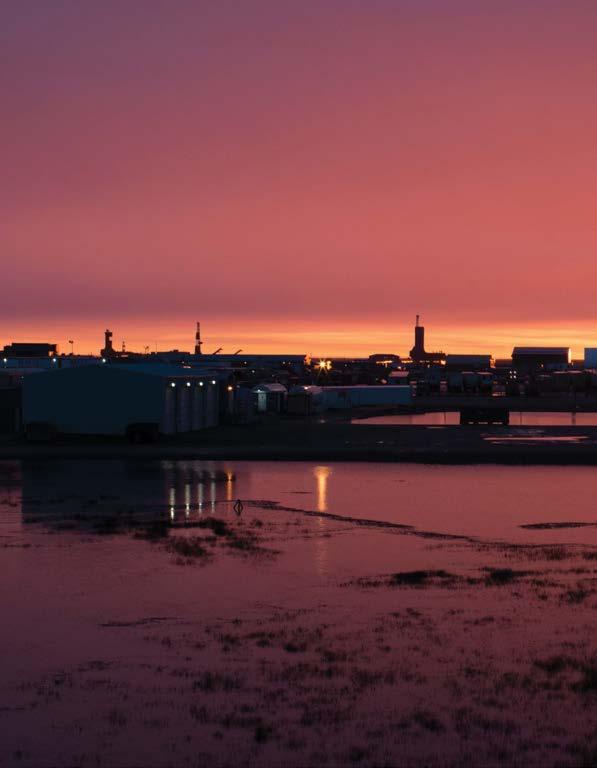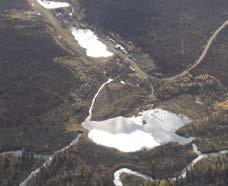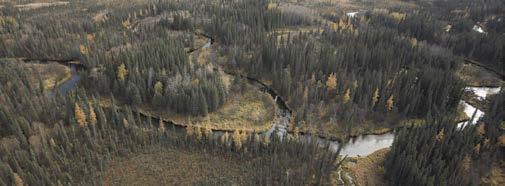
10 minute read
HILCORP POISED TO MAKE BIG STRIDES IN 2021
By Rindi White
Following the purchase of BP’s 26 percent interest in Prudhoe Bay in June 2020, Hilcorp became the state’s second-largest oil producer in Alaska.
This year, the privately held company has said it will begin a fast-paced gas and oil exploration plan at its Whiskey Gulch prospect on the Kenai Peninsula, bring gas at its Seaview prospect near Anchor Point to market, and drill a bevy of test wells for future gas development in Cook Inlet. On the North Slope, Hilcorp plans to continue BP’s path of development at Prudhoe Bay and continue with an ongoing and promising collaboration with the University of Alaska Fairbanks and other groups to pull heavy oils from mature wells.
Hilcorp: Revitalization Pro
Founded in 1989, Hilcorp made its Alaska debut in 2012 when it purchased Chevron’s Cook Inlet assets, a purchase that included Chevron’s interest in ten offshore oil platforms, onshore gas fields, two gas storage facilities, and two pipeline companies. In the nine years since, the company has made a name for itself by revitalizing aging energy infrastructure and breathing new life into mature developments. "Hilcorp has a proven track record of bringing new life to mature basins, including Alaska's Cook Inlet and the North Slope, and we have a clear understanding that an experienced local workforce is critical to success," said Hilcorp Energy Company president Jason Rebrook in a 2019 statement announcing the company’s plan to purchase BP’s Alaska interests for $5.6 billion.
At a time when North Slope oil production is steadily declining, with easy-to-reach oil reserves already pumped down the pipeline, many see hope in Hilcorp’s involvement. The company purchased a 50 percent stake in the Milne Point field in 2014 and, six years later, production had more than doubled.
Jason Rebrook, President, Hilcorp Energy Company
Whiskey Gulch, Seaview Moving Forward
The Alaska Division of Oil and Gas in March approved Hilcorp’s plan to drill
resourceful solutions
HELPING NATURAL RESOURCES CLIENTS NAVIGATE TURBULENT TIMES TO UNDERSTAND AND ADDRESS TODAY’S EVOLVING LEGAL LANDSCAPE.
Dorsey & Whitney’s Energy & Natural Resources attorneys assist clients with a wide range of oil & gas matters, providing timely and effective counsel to companies engaged in upstream, midstream, or downstream operations. Dorsey provides comprehensive representation, helping clients with everything from employment matters, corporate transactions, and litigation, to regulatory and environmental compliance.

Founded in 1989, Hilcorp made its Alaska debut in 2012 when it purchased Chevron’s Cook Inlet assets… In the nine years since, the company has made a name for itself by revitalizing aging energy infrastructure and breathing new life into mature developments.
two exploratory wells at its Whiskey Gulch project roughly 2 miles north of Anchor Point this year, one for gas and a second looking at both oil and gas prospects. The work, which includes improving access roads and building a 300-foot by 400-foot gravel pad before drilling the two wells, is set to happen over the summer and be wrapped up by September.
“We’re very, very excited about this one,” said Jennifer Starck, Hilcorp’s asset team leader for Kenai at a February 19 presentation to the Alaska Support Industry Alliance. “The exploration project was found four to five years ago, and we have been investigating it since.”
Starck said if the two exploration wells prove out, production at Whiskey Gulch could begin in 2022 or 2023, depending on permitting.
Hilcorp’s Seaview prospect, also near Anchor Point, is headed for production this summer. The company drilled an exploration well there at the end of 2019 but had problems connecting with ENSTAR’s nearby line due to directional drilling complications. An outside company with expertise in the field will drill the line this spring, and Starck said the company hopes to move to production this summer.
“Once we get the pipeline in place, we’ll be drilling additional penetrations in Seaview to get more gas into market,” she said.
Continued exploration is a priority for Hillcorp in 2021. The company is the primary oil and gas producer in Cook Inlet.
Starck said Hilcorp plans this summer to drill twenty stratigraphic wells, each around 650 feet deep, between the area north of Whiskey Gulch and south of Ninilchik to look for additional pockets of gas along the same structural line. She said the company will drill the wells in two pushes, in June and August, to avoid being on the roads during the heaviest summer use. Moving from the test well to marketable gas is a process that takes two to four years, she said.
Hilcorp’s assets in Cook Inlet aren’t limited to natural gas. Its holdings at the Swanson River, one of the oldest


– Evan Polty Jr.
Lead Mechanic, Donlin Gold
Born in Pilot Station and
Resident of Russian Mission
Respectful development for all generations.
producing fields in Alaska, deliver around 800 barrels of oil a day. Beaver Creek, near Nikiski, produces around 1,000 barrels a day, and a limited amount is produced at its Cannery Loop field near the mouth of the Kenai River.
Buying up and revitalizing aging assets isn’t without risk. In April Hilcorp had to shut down its two Cook Inlet oil platforms and the pipeline that carries natural gas to market when a helicopter pilot noticed bubbles on the surface of Cook Inlet, a sign of a leak in the 8-inch pipeline located 80 feet below the water’s surface. The US Department of Transportation Pipeline and Hazardous Materials Safety Administration weighed in. In an order dated April 6, Associate Administrator for Pipeline Safety Alan Mayberry said Hilcorp must replace the 7-mile line, which is more than fifty years old. The pipeline has had numerous leaks in recent years; the federal order says the April leak was the fifth since June 2014. Four of those were determined to be caused by rocks striking the pipeline in areas where it was not continuously supported by the seabed. A 2019 leak was caused by corrosion or weld imperfections. Hilcorp purchased the pipeline and related assets in September 2015.
The federal order requires Hilcorp to submit a plan to replace the affected pipeline segment, including cost estimates for doing so, by May 21.
Moving Forward with BP’s Plans
After obtaining approval from the commissioners of the Department of Natural Resources and the Department of Environmental Conservation in June 2020 and from the Regulatory Commission of Alaska in December 2020 for both the purchase of BP’s Alaska assets and its pipeline assets, Hilcorp last year set about strategically organizing its changing presence in the state.
As of February, Starck says the company has 1,503 full-time employees, including those that work with Harvest Alaska, its midstream operations subsidiary. It also works with 1,600 contractors, not counting additional contractors working on drilling operations. In February Hilcorp was operating two drilling rigs in Milne Point on the North Slope, plus a workover rig, and planned to operate two rigs in the summer in Cook Inlet.
As for Hilcorp’s plans on the North Slope, so far the company has only said that it is analyzing the field for ways to increase efficiencies and extend its useful life. It did just that after purchasing a 50 percent share of Milne Point, northwest of Prudhoe Bay, in 2014. BP owned the remaining 50 percent at the time. The field, developed in the mid-‘80s and operated by BP since 1994, had seen steadily declining production, based in part on poor pump performance. Hilcorp came in with fresh money, reworking old wells, drilling dozens of new wells, and building a new drilling platform: Moose Pad. The work paid off with steadily increasing production, about 40,000 barrels a day in 2020, up from around 18,400 barrels per day when Hilcorp took over operations in 2014.
New Techniques Yield Promising Results
In addition to investing more than half a billion dollars in Milne Point
Building Alaska for over 40 years

• Heavy Civil • Oil Field • Marine Transportation • Camps

Hilcorp’s assets in Cook Inlet aren’t limited to natural gas. Its holdings at the Swanson River, one of the oldest producing fields in Alaska, deliver around 800 barrels of oil a day. Beaver Creek, near Nikiski, produces around 1,000 barrels a day, and a limited amount is produced at its Cannery Loop field near the mouth of the Kenai River.
production, Hilcorp also joined with University of Alaska Fairbanks researchers on a four-year, $9.7 million study financed by the US Department of Energy to test a new technique for bringing heavy oils to market. The technique is in its third year of study at Milne Point and, according to a presentation prepared for October 2020, the results are inspiring.
“Initial scoping studies suggest that successful implementation… could increase heavy oil recovery by 50 percent on the North Slope of Alaska and increase America’s oil reserves by tens of billions of barrels,” states a summary about the project by the National Energy Technology Laboratory dated March 31, 2020.
Recovering heavy oils could be key to revitalizing the tapped-out areas of Prudhoe Bay, where most of the “easy oil” has already been recovered. Alaska’s heavy oil, unlike other heavy oil reserves, exists in relatively shallow pools and is colder, and therefore more viscous, than deeper oils.
The project is being tested at Schrader Bluff within the Milne Point Field. According to information from the National Energy Technology Laboratory about the project, Schrader Bluff sands were deposited around 70 billion years ago and consist of fine-grained sandstone mixed with silt and mud. The reservoir is about 15 feet thick.
Moving heavy oils with seawater, a common injection method, had already been tried at Milne Point. Using steam-based technology, which is the most common method for extracting heavy oils in oil fields and oil sands around the world, is not an effective tool on the North Slope because it could lead to permafrost thawing and result in significant and severe environmental impacts.
Advanced polymer flooding is a process by which polymers are added to water to thicken it and then the polymer-thickened water is injected into the basin over a period of time, pushing the heavy oils out toward production wells.
So far, results indicate the process is effective, with the barrel-per-day oil recovery rate jumping from an estimated 400 to 1,200 barrels per day in the test area.
While the study will wrap up in 2022, Hilcorp plans to continue and expand polymer injection use elsewhere in its holdings. As of October 2020, the company was using the method in nineteen wells at four different pads within the Milne Point unit, with plans to expand to two to four new pads in the near future.
“Encouraged by the promising results of this pilot, Hilcorp Alaska is planning to apply polymer flood technology in the Schrader Bluff reservoir throughout the Milne Point Field,” study participants noted in their October 2020 presentation at the Society of Petroleum Engineers Annual Technical Conference and Exhibition.
Hilcorp company leaders tout their innovative approach to doing business as part of the reason they are quickly becoming an industry leader. The company has a fivepronged approach: Integrity—do the right thing; Urgency—act today, not tomorrow; Ownership—work like you own the company; Alignment—when Hilcorp wins, we all win; Innovation— get better every day.
Starck, who spent about twenty years working for BP, mostly in Alaska, before joining Hilcorp in Kenai, gave rare comments about key differences between the corporate culture of BP and Hilcorp at her Alliance presentation.
“Now, I’m an asset team leader. I run the asset as if it’s my business,” she says. “The decisions, good and bad, are mine to own. And at the end of the day, the decisions that go well—the team did well. And when it goes bad, I planned the wrong way.”
For Hilcorp, the approach seems to be paying off.









